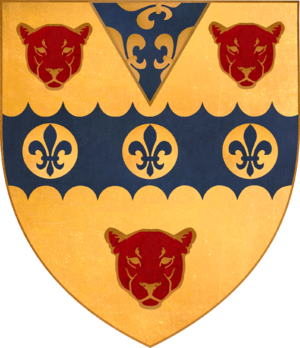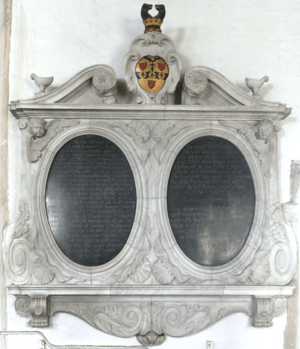Peter Sainthill (MP for Tiverton) facts for kids
Peter Sainthill (born 8 July 1593 – died 12 August 1648) was an important person from Bradninch in Devon, England. He was chosen twice to be a Member of Parliament (MP) for Tiverton. This happened in 1640, first for the Short Parliament and then for the Long Parliament.
Peter Sainthill was a strong supporter of King Charles I during the Civil War. He was known as a "Cavalier," which was the name for those who supported the King. People described him as a kind and cultured man. A long poem, called Peter's Banquet or The Cavalier in the Dumps, was written about him around 1645.
Contents
Who Was Peter Sainthill?
Peter Sainthill was born on 8 July 1593 in Bradninch. His father was Peter II Sainthill, who also lived at Bradninch House. His grandfather, Peter I Sainthill, was also a Member of Parliament.
Peter's mother was Elizabeth Martin. Her father, Thomas Martin, was a Doctor of Civil Law and an MP from Cambridgeshire. The Sainthill family originally came from a place called Saint Hill in Devon, not far from Bradninch.
Peter's Early Life and Work
Peter Sainthill went to the Free Grammar School in Tiverton, Devon. This school is now known as Blundell's School. He was one of the first students there. The school was founded by a rich cloth merchant named Peter Blundell.
Peter Sainthill later became the Recorder of Bradninch. This was an important local job. Bradninch was an old town with a long history. It was once a main center for the Dukes of Cornwall, who were the eldest sons of the King.
Peter Sainthill and the Civil War
In April 1640, Peter Sainthill was elected as an MP for Tiverton. He was re-elected in November 1640 for the Long Parliament. However, he strongly supported King Charles I. Because of this, he was removed from Parliament in January 1644.
When the Civil War started, Peter Sainthill was one of 118 MPs who met in Oxford. This meeting was called by the King in January 1643. Peter Sainthill signed a letter to the Earl of Essex on 27 January 1643. As a result, Parliament demanded that Peter Sainthill be removed from the King's court and councils. They also wanted him to be unable to hold any future public office. They even wanted a third of his property to be used to pay public debts.
Peter Sainthill was also a Captain of his local "Trained Band." These were groups of local men who were trained to fight. The King's officials raised many such groups in Devonshire.
In the summer of 1644, King Charles I visited Devon. He stayed at Bradninch House with Peter Sainthill for one day and night on 27 July 1644. It is believed that Peter Sainthill loaned the King money for the war. To thank him, the King supposedly carved his initials into a wooden door at the house. The King's army later stayed in and around Bradninch on 17 September 1644.
Peter Sainthill was also chosen as one of the "Commissioners for managing the King's affairs in the West." He met with the Prince of Wales (the King's son) in Bridgwater on 23 April 1645. They discussed the best ways to help the King.
Life in Italy and His Death
As the Royalists began to lose the war, Peter Sainthill had to flee. The Parliamentarian army, led by General Thomas Fairfax, took over Bradninch on 16 October 1645. Peter Sainthill, his wife, and children found safety in the city of Exeter.
After Exeter surrendered to Parliament on 9 April 1646, Peter Sainthill received permission from General Fairfax to leave. He was allowed to travel safely with his servants, horses, and weapons. He then went into exile in Italy. In early May 1646, he arrived in Leghorn in Tuscany. He stayed with his younger brother, Robert Sainthill, who was a merchant there. Robert was also an agent for Ferdinando II de Medici, the Grand Duke of Tuscany.
Sadly, Peter Sainthill became ill shortly after arriving in Italy. He died on 12 August 1648, at the age of 54.
A Satirical Poem About Peter
(You can read the full poem on Wikisource: s:Peter's Banquet, or, The Cavalier in the Dumps)
Peter Sainthill was the subject of a long, funny poem. It was written by the "Roundheads," who were the King's opponents. The poem is called Peter's Banquet or The Cavalier in the Dumps. It was written around 1645, after the Battle of Naseby on 14 June 1645. The poem describes the scene on that day.
Here are some lines from the poem:
- Now when the king was in the West,
- And not a little in distress,
- He honoured Peter with a call
- By night, incog., but that 's not all,
- He wanted money for to spend
- In waging war, that was the end,
- And he knew those that had to lend.
- To make the pledge more firm and sure,
- Etched his sign manual on the door.
And:
- In Peter's great and lofty hall,
- Seated in order for to dine,
- Swig cyder, beer, and meady wine.
Peter's Family
On 12 May 1614, Peter Sainthill married Dorothy Parker in Bradninch. Dorothy was the daughter of Robert Parker. The satirical poem about Peter calls her "Dame Dolly."
Peter and Dorothy had several children, including:
- Peter IV Sainthill (born 1618): He was their first son, but he died when he was very young.
- Samuel Sainthill (1626-1708): He was their second son and became the main heir. Samuel managed to get back much of his father's property. This property had been taken by the government during the Civil War. In 1679, Samuel put up a monument for his father in Bradninch Church. Samuel never married.
Samuel was expected to leave his property to his cousin, John Sainthill. However, he changed his mind and left his estates to his nephew, Edward Yarde. Edward was the son of Peter's sister, Dorothea Sainthill. Edward Yarde later changed his last name to Sainthill.
Peter's Monument at Bradninch
There is a beautiful monument to Peter Sainthill in St Disen's Church in Bradninch. It is on the north wall of the church's main area. His son, Samuel, put it there in 1679.
The monument has two black marble tablets. These are set in a white marble frame. Above them are the Sainthill family crest and arms.
The tablet on the left says:
- "To the memory of Peter Sainthill, Esq., well knowne in this place for his piety, charity & justice, sonne of Peter Sainthill, Esq., and grandsonne of Peter Sainthill, Esq., all inhabitants of this ancient Burrough (the 2 last lying in a vault under the Communion table in this chanc'll), who having served K. Charles the 1st in honorable charges, both civil & military, according to the obligation of his oath to reserve himselfe for more successful service to his King and country, in the yeare 1646 withdrew into Italy to his brother Robert Sainthill, Esq., then agent with the greate Duke of Tuscany from K. Charles the 1st, where having spent the remainder of his life in the exercise of vertue & devotion, & lamenting the miseries a civil warre had brought upon his country, he resigned his spirit to God who gave it, in the yeare of Grace 1648 & the 54th yeare of his age."
The tablet on the right says:
- "Samuel Sainthill, his son and heir, both of his fidelity to his Prince and estate, though impayr'd & lessen'd by his father's loyalty, dedicates this marble, and desires the memory of ye reader for the piety of the act w'ch he caus'd to be don in the yeare of Grace 1679. Caetera Memorent Posteri. The above mention'd Sam'l Sainthill, Esqr. who erected this monument, lyes also buried under ye Commu'on table of this Church. He departed this life ye 14th of Novem'r 1708 in ye 83d yeare of his age"




